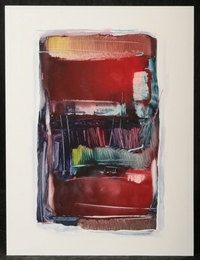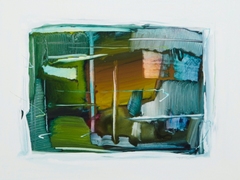Asheville Museum of Art
 “.....Upon entering the main gallery....one finds three Graffagnino abstracts. The first one offers a feeling of an Arizona or Western landscape. Some may be reminded of the geological formations found in the cliffs and sides of the Grand Canyon."
“.....Upon entering the main gallery....one finds three Graffagnino abstracts. The first one offers a feeling of an Arizona or Western landscape. Some may be reminded of the geological formations found in the cliffs and sides of the Grand Canyon."
“The textures and colors project a sense of mineral-laden shale and rock. Graffagnino's abstract technique with the translucent effects of the gouache allows him an unlimited freedom to escape into another dimension through his art."
“The middle painting of the three, slightly larger than the others, is held to soft greens and yellows whose combinations create in the viewer's mind a quiet, dreamlike journey ito the artist's private world."
“Graffagnino is meticulous with his assignment of the color patterns and shapes that he assembles into his final composition. He keeps abstract shapes in continual checkmate by his comfortable juxtaposition of limited but related colors. The composition with its central aperture of sky, depth, or void pulls the viewer into the heart of the painting.
“The third, smaller and containing fewer elements, is an abstract that plays on the mind as children's building blocks, balancing one on another, and then refutes the though. It is a study of strong shapes that indicate a much heavier and more massive form perhaps a colorful Stonehenge"
“A second group of pictures on the long wall are the crux of pure abstract painting. Again, Graffagnino's technique and treatment of his shapes and color suggests ethereal landscapes or collections of unrecognizable objects wrenched from the soil. A surprising three-dimensional effect is captured by contrasting use of colors that recede against those that appear to fight to come forward."
“Two other Abstracts that deal with warm colors and a sliding scale of reds and oranges with the suggestions of the yellows cast a tropical feeling, quite different from the previous paintings."
“Graffagnino is deeply engrossed in reaching the desirable Abstract and is successful in leading us into his world of fantasy and unknown depths that only he has seen, but explains to us through these artful and delightful Abstracts......”
Richard A. Genders
A Review from the Asheville Citizen-Times
1985


